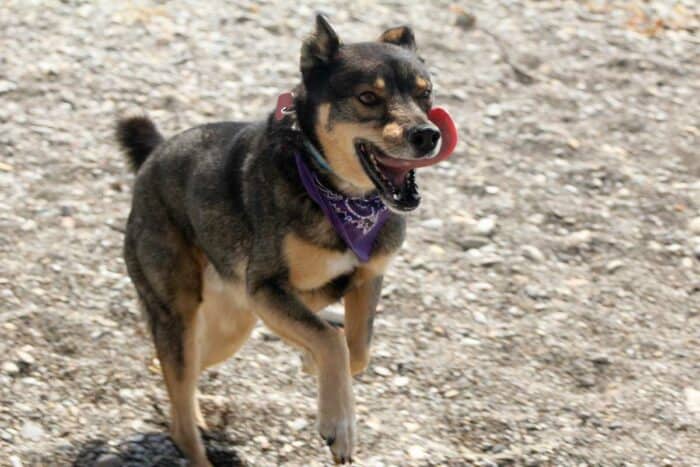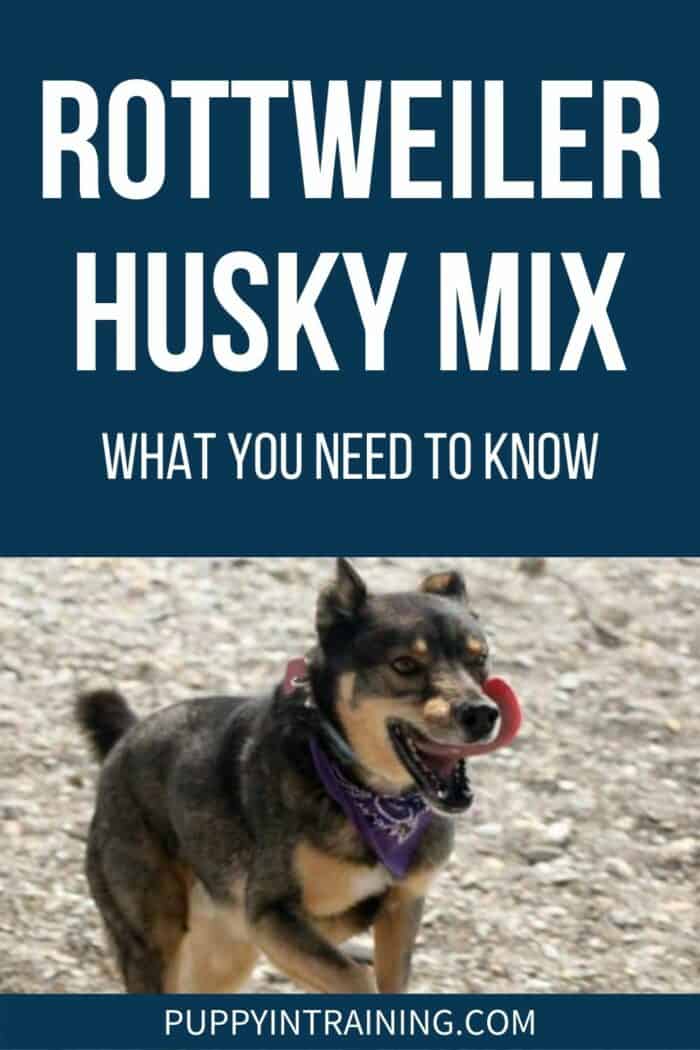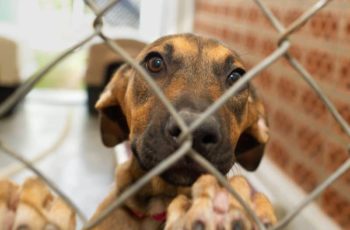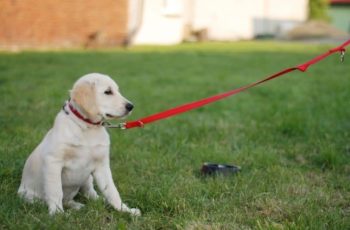This post may contain affiliate links. We may earn money or products from the companies mentioned in this post.
What do you get when you mix a strong and protective Rottweiler with an athletic and friendly Husky?
Rottskies are one of the latest designer breeds taking the country by storm.
While we never advocate choosing designer breeds for the sake of having the latest canine accessory, if you do have your eye on a particular Rottsky pup, they can make very good family pets.

Loving and loyal, these energetic dogs are a lot to handle and aren’t recommended for inexperienced owners.
But if you love boisterous dogs that will want to accompany you on all of your adventures, then you might be very happy with this distinctive crossbreed companion.
In this article, we will take you through what to expect from a Rottsky in terms of size, appearance, temperament, energy levels, and more.
It is important to remember that, unlike with purebred dogs, the characteristics of two parents can combine in unexpected ways with crossbreeds.
There is no “true breed,” and you can never know exactly what you are going to get. It pays to expect the unexpected when adopting a crossbreed.
Rottsky Main Characteristics
- Height 20-26 inches
- Weight 40-110 pounds
- Activity Level: High
- Shedding Level: High
- Lifespan: 9-13 years
History Of The Rottsky
Rottweilers were originally bred in Germany to assist pitchers, both with herding livestock and pulling carts laden with meat to market. This means they needed to be both athletic and strong to complete their work.
They are intelligent and biddable dogs. This, combined with their strength, has made them popular working dogs for police, military, and search and rescue.
Rottweilers also have a reputation for being aggressive, but this is undeserved and mostly due to how the breed has been misused over the years rather than on their natural temperament.
In fact, they tend to be good-natured and even placid with an obedient disposition and are eager to please. The dog is very alert, suspicious of strangers, and has a tendency to fiercely defend their home territory.
Overall, Rottweilers make great guard dogs and companions when properly trained.
Siberian Huskies, on the other hand, originally come from Northeastern Asia. They were bred in Siberia to pull sleds, so they are an active breed that loves to run. However, they also lived in close quarters with their people, so they are excellent family pets.
They were imported to Alaska in the 1900s to work with miners during the Alaskan Nome Gold Rush, and they have been popular with Americans ever since as pets in part because of their wolf-like look.
They are friendly and intelligent dogs, but they are also very independent.
This means that rather than being highly obedient, they can be troublemakers if not socialized and trained properly, resorting to chewing, digging, and otherwise destroying when they are bored.
Aside from their size, these dogs are very different in temperament and appearance, so it can be quite difficult to predict what exactly you will get when you bring the two of them together.
Rottsky Average Size
You can expect Rottweiler Husky mixes to be relatively large dogs mostly thanks to their Rottweiler parents. Rottweilers tend to measure between 22 and 27 inches and weigh a respectable 90 to 135 pounds.
They have a lot of dense muscle, which is why they tend to be so heavy.
Huskies have a more lean and athletic physique. They range from 20 to 24 inches in height and weigh a much more manageable 35 to 60 pounds, with the males tending to be larger than the females.
This means there’s a pretty wide range of sizes with Rottskies. On average, they measure from 21 to 26 inches in height and weigh between 45 and 120 pounds.
If possible, look at your prospective pup’s parents to get a good idea of how large your dog will be. Usually, the mother is the larger of the two dogs, as this ensures she will be able to give birth without encountering the problem of her pups being too big for her.
You can expect male pups to be almost the size of their mothers when fully grown, while female pups can be much smaller.
Rottsky Appearance
Rottskies tend to be leaner than Rottweilers but heavier than Huskies, so they look athletic but strong.
Rottweiler/Husky offspring will usually have either blue or brown eyes, and will occasionally have one of each, a trait that is quite common in Huskies.
They tend to have a relatively long but also wide muzzle, so they have a flatter face than you are accustomed to seeing with a Husky thanks to the Rottweiler’s more snub-nosed appearance.
Rottskies can either have wolf-like ears that stand on end, like a Husky, or the more floppy ears of a Rottweiler. You might not be able to tell which they will have when they are puppies, as it can take several months for their ears to decide to stand up.
Rottsky Coat Characteristics
Rottskies can be almost any color, including black, grey, brown, red, cream, and sable, but their fur color is always combined with a black, brown, or liver-colored nose.
The most popular Rottskies tend to be mostly black or dark brown in coloration, with lighter hair around the mouth, chest, and legs.
Both parent dog breeds have heavy shedding double coats, so you can be sure that their crossbred offspring will present with this as well. However, the texture can vary significantly.
Rottweilers tend to have a short coat that grows flat against their body, while Siberian Huskies have a shaggier medium-length coat. Either manifestation is possible when you bring the two of them together.
If you are lucky, they will have the low-oil coat of a Husky. While this doesn’t prevent them from shedding, it means they don’t have the same strong “dog smell” as many dogs are known for.
But it does mean they can be prone to dry skin, so you need to be careful to use moisturizing shampoo when bathing them. We recommend CHI Deep Moisture Dog Shampoo.
However, Rottskies do need to be washed and brushed regularly, as their high-shedding coat can cling to them, trapping dirt and leading to itchy skin.
Rottsky Temperament: Athleticism
You can expect a Rottsky to be both strong and agile. Rottweilers are very strong and muscular dogs capable of hard work. Huskies are strong as well, but they are bred more for speed and agility.
Combine these two characteristics, and you are very likely to get a dog that has a lot of energy. In turn, they will struggle with being cooped up in small spaces, so keep this in mind when adopting this crossbreed.
Rottweiler Husky mixes should receive a lot of exercise, going out at least twice a day for a minimum of 30 to 60 minutes at a time. Off-leash dog parks are ideal, as these dogs need to be able to stretch their legs rather than always being tethered to a leash.
Need advice on walking your dog? Read our dog walking tips for the best experience.
The Rottsky’s large size also means they need quite a bit of space at home, so they won’t cope well with apartment living. A home with a big backyard is ideal.
But bear in mind that you will also need tall fences. Huskies, in particular, are escape artists. If you don’t want them getting out, you need to secure your space as though it is Fort Knox!
Rottsky Temperament: Trainability
Both Rottweilers and Huskies are highly intelligent, so it won’t take them long to pick up on training cues and figure out what you want from them. However, whether they will deliver or not is another question.
While both breeds do like to please, they can also be very stubborn.
This is especially true on the Husky side, as they were bred to make decisions about terrain and direction without the need to consult humans, whereas Rottweilers were bred to be a bit more dependent.
The result is that Rottskies aren’t as trainable as some more popular large breeds, such as Golden Retrievers, Labradors, or German Shepherds. But they are still very trainable, especially if you start from a young age.
It is important to set yourself up as the leader of the pack. If you don’t, then they will often try to step into that role and make training more difficult for you. They are best trained by experienced dog owners or with the help of a professional.
Looking for a trainer for your dog? Read our guide on choosing the right trainer.
If you train your dog properly, you will be able to count on them to “leave it” when you give them the command when you are at the dog park.
Still, you might not be able to trust them not to keep digging at the hole under the fence in your backyard if you go out and leave them at home for ten hours.
Rottsky Temperament: Independence
Both Rottweilers and Huskies like to belong to a pack, and they will adopt you and your family as their pack pretty quickly.
This means they are affectionate and loving, and they can also be protective. They will often jump up to protect younger family members from anything they perceive as a threat.
Both breeds thrive on human companionship, and they tend to need quite a bit of mental stimulation. As a result, they don’t necessarily do well when they are left alone for extended periods of time.
Rottskies can develop anxiety and depression if they don’t get enough love and affection. They can also be troublemakers when they are bored. Leave them alone with nothing to do for ten hours, and you may come home to quite a bit of destruction.
These dogs do best in households when there is usually someone about to monitor and interact with them. Their independent nature means that they aren’t always underfoot, but just having people around tends to be enough to curb their worst behaviors.
Rottskies don’t tend to bark for no reason, but they will certainly speak up if they want to alert you to something. If you are lucky, you might find that your pup has the distinctive Husky wolf-like howl.
Rottsky Health Concerns
Rottskies have relatively long lifespans for dogs their size, typically living between 9 and 13 years. Larger dogs tend to have shorter lifespans than their smaller cousins.
The most common health concern affecting these dogs are joint problems, in particular hip dysplasia. This is when the hip socket becomes malformed, restricting strength and movement and potentially causing your dog pain.
A healthy diet and sufficient exercise can help prevent the development of hip dysplasia, and an orthopedic bed that takes some pressure off their hips will help them a lot in later life.
Rottskies can also tend to lose their vision over time, and will probably at least partially lose their eyesight as they enter old age. In extreme cases, they can go completely blind.
Who Should Adopt A Rottsky?
So, would a Rottsky make a good dog for you? Well, that depends on a few key factors. Here are a few questions to ask yourself in order to decide.
Are You Experienced With Dogs?
While Rottskies are highly trainable, they are also very independent and can be a bit of a handful. They need a strong and confident leader to keep them in hand and to keep control of such a large dog.
Rottskies are most appropriate for experienced dog owners who know what they are doing. If you are new to dog ownership, you will be taking on a very big challenge.
How Much Space Do You Have?
Rottskies are large dogs with lots of energy, so they need quite a bit of space. If you live in an apartment, you will probably find that it is too small for them.
Additionally, if you have a backyard, will you be able to make it secure? These dogs tend to be pretty good at finding a way to escape, so keep this in mind.
Do You Spend A Lot Of Time Outside Of The House?
Rottskies aren’t the type of dog you can leave at home alone for ten hours while you are at work. They become bored and lonely easily and are likely to engage in destructive behavior when left alone for too long.
Are there usually people around the house? Could you take your dog to work with you?
Do You Have An Active Lifestyle?
Rottskies are energetic dogs that need lots of exercise. They need to be walked at least twice a day for at least 30 minutes at a time, and they also enjoy being taken on family hiking trips.
Is this compatible with your lifestyle? If not, you might want to reconsider adopting this crossbreed.
Are You Prepared For The Commitment Of Being A Pet Parent?
Before adopting any dog, you should ask yourself whether you are ready for the commitment of being a pet parent.
You will be committing to caring and taking care of a dog for the next 10 to 15 years (depending on the age of the dog), including feeding them, paying for medical treatment, finding someone to care for them when you travel, and much more.
Are you prepared to make that commitment?
Rottsky FAQs
Do Rottskies like to cuddle?
Rottskies do like to cuddle, but they will only get that close with people they know well. They will be happy to curl up with you and other family members, but they can be a bit wary of strangers.
Why does my Rottsky lean on me?
When your dog decides to lean on you, this is often a sign of affection and trust. They are trying to get close to you and they are comfortable enough with you to let you support their weight.
Of course, they aren’t small dogs, so if this is uncomfortable for you, you can show them other ways to show their trust and affection.
What are some popular Husky crossbreeds?
In addition to Rottskies, which are a mix of a Husky with a Rottweiler, other popular Husky crossbreeds include Shepskies, which combine a Husky with a German Shepherd, Aluskies, which are mixed with an Alaskan Malamute, and Chuskies, which are mixed with the Chow Chow.
Are Rottskies aggressive?
While Rottskies do not tend to be aggressive, they can be territorial. As a result, they will often stand their ground in front of other animals that they perceive as a threat.
They also have a high prey drive, so it can be hard for them to fight the urge to chase cats and other small animals.
Rottskies are often wary of strangers, and won’t befriend everyone they meet. However, they will generally only display aggressive behavior if they sense a threat. Good, consistent training during puppyhood is critical.
The Verdict
Rottskies, a crossbreed mix between a Rottweiler and a Husky, are adorable dogs that make a wonderful addition to any family. But they can be quite a handful if you’re not prepared, so make sure your lifestyle is compatible with the breed.
Rottskies are best for experienced dog owners with a lot of space and an active lifestyle that their pup can participate in.
If that sounds like you, then the Rottsky will reward you with a lot of loyalty and affection.
Do you have experiences with Rottskies?
Share your insights with the community in the comments section below.
Save To Pinterest

Top Picks For Our Puppies
- BEST PUPPY TOY
We Like: Snuggle Puppy w/ Heart Beat & Heat Pack – Perfect for new puppies. We get all of our Service Dog pups a Snuggle Puppy. - BEST DOG CHEW
We Like: Best Bully Sticks – All of our puppies love to bite, nip, and chew. We love using Bully Sticks to help divert these unwanted behaviors. - BEST DOG TREATS
We Like: Wellness Soft Puppy Bites – One of our favorite treats for training our service dog puppies. - BEST FRESH DOG FOOD
We Like: The Farmer’s Dog – A couple months ago we started feeding Raven fresh dog food and she loves it! Get 50% off your first order of The Farmer’s Dog.
Check out more of our favorites on our New Puppy Checklist.


